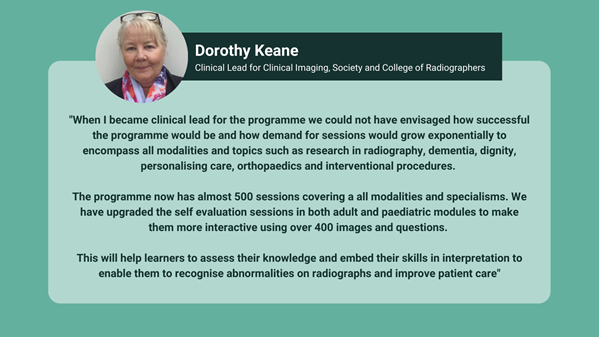In this section
In This Section
If you work outside the UK or are not eligible for free access to the eLearning for Healthcare programme, you can access the same training via eIntegrity (learn more below).
The impact on patients
To work as a radiographer in the UK you must be registered with the Health and Care Professions Council (HCPC). The HCPC regulates 15 health and care professions and this includes therapeutic and diagnostic radiographers.
A therapeutic radiographer often provides care for cancer patients by planning and delivering treatment using radiation. While a diagnostic radiographer will diagnose injuries and diseases by producing and / or interpreting high-quality images of the body.
To be HCPC registered, means a radiographer meets the required professional standards needed to provide safe and effective patient care. Registration also means a commitment to undertake regular continued professional development (CPD), to ensure they continued to learn and develop their skills and knowledge.
The Clinical Imaging elearning programme provides radiographers with a quick and easy CPD option. By supporting radiographer development, our programme helps to improve the care patients receive when undergoing treatment.
About the programme
The College of Radiographers developed the Clinical Imaging e-learning programme (previously known as Image Interpretation) in collaboration with the Health Education England elearning for Healthcare programme.
We designed our programme to support the development of all imaging staff in areas of clinical practice and importantly enhancing the patient experience.
Launched in 2010, the programme initially had 20 learning sessions (online course modules). As of February 2022 there are over 500 free sessions that form the Clinical Imaging programme.
Video: A selection of feedback from healthcare professionals who have undertaken part of the Clinical Imaging programme. Please note: the video has no sound.
What healthcare professionals can learn
Our patient care sessions focus on improving understanding of how to provide imaging services to patients with disabilities, dementia and those with specific needs along with topics such as consent for procedures, clinical governance and professional development.
Clinically, our course covers a range of topics providing bite-sized content to help enhance and maintain imaging skills in Radiography, Computed Tomography (CT), Magnetic Resonance Imaging (MRI) and Ultrasound. This also includes developing reporting skills for those working in specialised modalities. For example:
- Cardiac radiography which can be used to assess the size of the heart, how blood is flowing and if there are any problems.
- Dental imaging is the use of x-rays by a dentist to evaluate the oral health of their patients.
- Forensic radiography, a specialism that relates to any situation where imaging is used to help with legal investigations. This could be identifying any pre-existing trauma to a skeleton or assisting in determining how someone has died.
- GIGU (Gastrointestinal and genitourinary) radiology, an examination that looks at your oesophagus, the muscular tube connecting your mouth to your stomach.
- Neurointerventional radiology which uses advanced imaging techniques for the diagnosis and treatment of neurological conditions like a stroke or brain aneurysms.
- Nuclear medicine imaging refers to using radioactive substances to help diagnose and treat a patient, particularly looking at how organs are functioning or structured.
- Orthopaedics as a specialism focuses on injuries or diseases that affect muscles or the skeleton. This covers your bones, joints, ligaments, tendons, muscles and nerves for example.
- Osteoporosis is a health condition that weakens bones, meaning they are fragile and more likely to break.
While our free resource is open to all health and care professionals in the NHS, the Clinical Imaging programme is there to support imaging professionals (including assistant practitioners, students, sonographers, early career radiographers and those involved in research, reporting and advanced practice) enhance their skills.
To view an example of a programme session, select one of the options below:
- General Introduction: Obtaining Consent
- Role of CT and MRI in Neurological Emergencies
- General Principles of Imaging in the Operating Theatre
Three benefits of learning online
- Self-directed learning using our extensive range of topics
- Interactive engaging sessions you can access 24/7
- Designed with reflective practice in mind
Understanding the impact: read our case studies
To read the case studies, please select an image below:
What’s next for Clinical Imaging?
The Clinical Imaging team meet regularly to review the performance of existing content, monitor feedback and develop new elearning sessions that reflect changes in imaging and the wider NHS.
As of February 2022, we know that:
- 71,520 healthcare professionals have enrolled on our programme (since it was launched in 2010)
- 97,694 sessions were accessed in 2021
- 46,277 hours spent learning in 2021
- 7,702 diagnostic radiographers are active users (the largest staff group)
- 3,506 student users (across all specialisms)
- Our feedback average is 4.4/5 from 17,196 reviews
In 2022 we are launching sessions covering bone and soft tissue pathology seen on conventional radiographs and we will begin our next development phase covering paediatric pathology.
How to access Clinical Imaging
Use one of the following methods to start your learning:
- Click here and then sign in to your e-Learning for Healthcare (eLfH) account. If you do not have an account already, you will need to register.
- NHS England staff can access Clinical Imaging via the Electronic Staff Record (ESR), which ensures your e-learning completions follow you throughout your NHS career.
- If you’re based outside of the UK or not eligible for free access to eLfH, you’ll be able to access the same training via *eIntegrity.
*eIntegrity is a Community Interest Company (CIC), an arm’s length from NHS England. eIntegrity sells the healthcare elearning materials developed by the UKs Medical Royal Colleges and other professional bodies in collaboration with NHS England, Technology Enhanced Learning, to international learners and those not eligible for free NHS access here in the UK.





